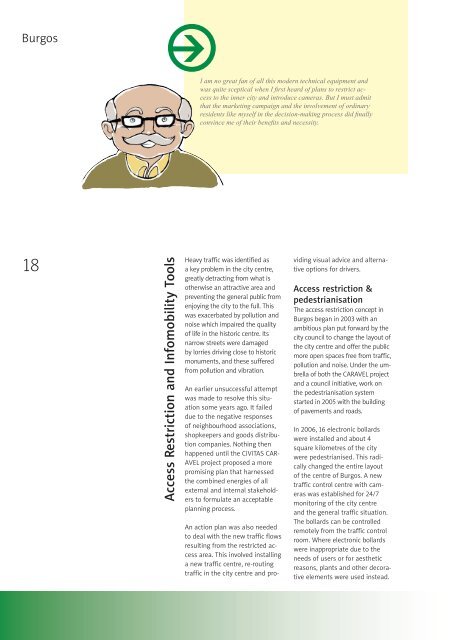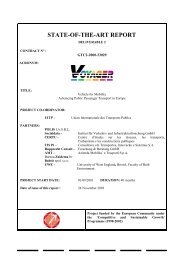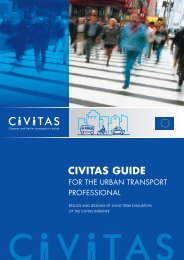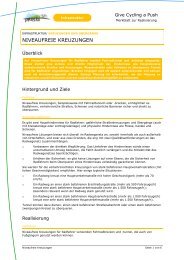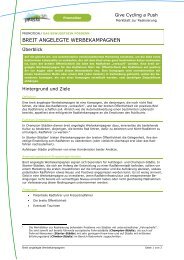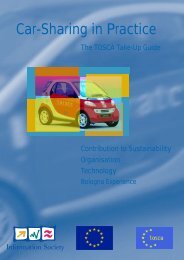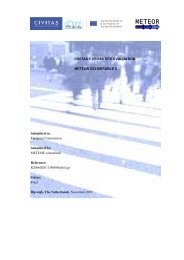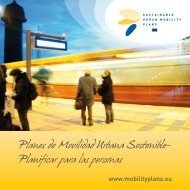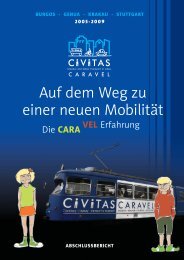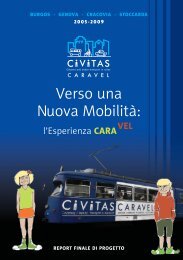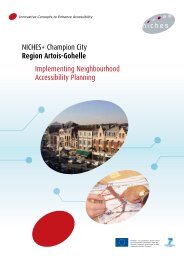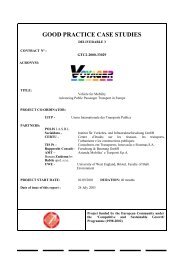CARAVEL Final Project Report EN - CIVITAS
CARAVEL Final Project Report EN - CIVITAS
CARAVEL Final Project Report EN - CIVITAS
You also want an ePaper? Increase the reach of your titles
YUMPU automatically turns print PDFs into web optimized ePapers that Google loves.
Burgos<br />
I am no great fan of all this modern technical equipment and<br />
was quite sceptical when I fi rst heard of plans to restrict access<br />
to the inner city and introduce cameras. But I must admit<br />
that the marketing campaign and the involvement of ordinary<br />
residents like myself in the decision-making process did finally<br />
convince me of their benefi ts and necessity.<br />
18<br />
Access Restriction and Infomobility Tools<br />
Heavy traffic was identified as<br />
a key problem in the city centre,<br />
greatly detracting from what is<br />
otherwise an attractive area and<br />
preventing the general public from<br />
enjoying the city to the full. This<br />
was exacerbated by pollution and<br />
noise which impaired the quality<br />
of life in the historic centre. Its<br />
narrow streets were damaged<br />
by lorries driving close to historic<br />
monuments, and these suffered<br />
from pollution and vibration.<br />
An earlier unsuccessful attempt<br />
was made to resolve this situation<br />
some years ago. It failed<br />
due to the negative responses<br />
of neighbourhood associations,<br />
shopkeepers and goods distribution<br />
companies. Nothing then<br />
happened until the CiViTAS CAR-<br />
AVEL project proposed a more<br />
promising plan that harnessed<br />
the combined energies of all<br />
external and internal stakeholders<br />
to formulate an acceptable<br />
planning process.<br />
An action plan was also needed<br />
to deal with the new traffic flows<br />
resulting from the restricted access<br />
area. This involved installing<br />
a new traffic centre, re-routing<br />
traffic in the city centre and pro-<br />
viding visual advice and alternative<br />
options for drivers.<br />
Access restriction &<br />
pedestrianisation<br />
The access restriction concept in<br />
Burgos began in 2003 with an<br />
ambitious plan put forward by the<br />
city council to change the layout of<br />
the city centre and offer the public<br />
more open spaces free from traffic,<br />
pollution and noise. Under the umbrella<br />
of both the <strong>CARAVEL</strong> project<br />
and a council initiative, work on<br />
the pedestrianisation system<br />
started in 2005 with the building<br />
of pavements and roads.<br />
In 2006, 16 electronic bollards<br />
were installed and about 4<br />
square kilometres of the city<br />
were pedestrianised. This radically<br />
changed the entire layout<br />
of the centre of Burgos. A new<br />
traffic control centre with cameras<br />
was established for 24/7<br />
monitoring of the city centre<br />
and the general traffic situation.<br />
The bollards can be controlled<br />
remotely from the traffic control<br />
room. Where electronic bollards<br />
were inappropriate due to the<br />
needs of users or for aesthetic<br />
reasons, plants and other decorative<br />
elements were used instead.


